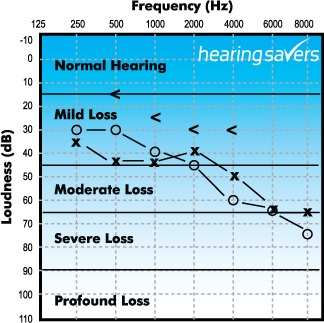What is an Audiogram?
An audiogram is a ‘picture’ of your hearing
An audiogram indicates how much your hearing varies from normal and, if there is a hearing loss, where the problem might be located in the auditory pathway.

Vertical Axis
The vertical axis represents loudness, which is measured in decibels (dB). Zero decibels (0 dB) does not mean ‘no sound’ - it is extremely soft. Conversational voice level is around 60 dB, and 120 dB is extremely loud - about as loud as a jet taking off.
Normal hearing is up to 15-20 dB. Beyond this threshold is a hearing loss.
Horizontal Axis
The horizontal axis represents frequency (or different pitches of sound) ranging from 125 to 8,000. Frequency is expressed in terms of the number of cycles per second, or Hertz (Hz). The higher the number, the higher the pitch of the sound. For example, 250 Hz sounds like a deep rumble, while the high-pitched ringing of the telephone is about 3,000 Hz.
Young, healthy human ears can actually hear frequencies as low as 20 Hz and as high as 20,000 Hz, but we generally test hearing in the range of 250 to 8,000 Hz, as most sounds of speech occur in this frequency range.
Hearing Tests
Two primary tests are depicted on the audiogram:
- Air Conduction
- Bone Conduction
Air conduction is performed by playing pure tones across the frequency range through headphones, typically in a sound proof booth. It measures hearing across the entire auditory pathway - outer ear (pinna & canal), middle ear (ossicles & ear drum) and inner ear (cochlea & auditory nerve).
Air conduction thresholds for the right ear (that is, the softest sounds the right ear can detect at each frequency) are marked with an ‘O’, and the left ear with an ‘X’ on the audiogram.
Bone conduction tests the sensitivity of the cochlea in isolation. A small oscillator is placed on the mastoid bone and sound waves are transmitted directly through the bone to the cochlea, bypassing the outer and middle ear. The right ear is represented by '<' and the left with '>' (not shown) on the audiogram.
























